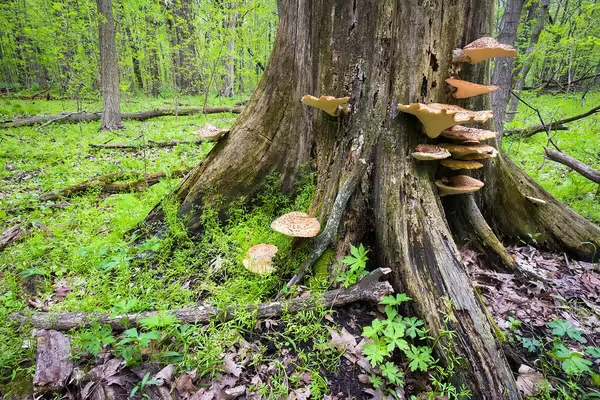
URBANA, Ill. — Every spring, nature reminds us of the beauty of the wild spaces that surround us. Wildflowers bloom in the forest understory. Mushrooms pop up overnight in your front yard. The sun sets slowly over a lake. Explore tips to manage the threat of invasive plants, explore the fungus among us, and learn about microplastic pollution with the Everyday Environment webinar series.
Led by environmental experts, this University of Illinois Extension program explores a new natural resource topic each month and provides small and meaningful ways to connect with nature and improve the environment through sustainable practices. Live online sessions are 1 to 2 p.m. on a select Thursday from April to June.
- Do’s and Don’ts for Managing Invasive Plants in the Spring | April 11
Non-native invasive plants can cause a lot of damage in backyards and wild spaces across Illinois, and managing them is a year-long endeavor. Some management activities are best suited for spring, such as garlic mustard control or surveying for invasive bush honeysuckle. Other tasks are more effective later in the year, such as removing invasive woody plants. Explore invasive plant phenology, identification, the most effective timing for management, and best practices for springtime control with Chris Evans, forestry Extension and research specialist.
- Fungus Among Us: An Insight to Fungi in Illinois Ecosystems | May 9
Fungi are more than a pathogen eating your trees or the mushroom in your meals. Not a plant or an animal, fungi are dynamic organisms that help decompose and recycle the nutrients in organic materials and form beneficial relationships with plants. About 400 million years ago, fungi were the catalyst that prompted life to move from the sea to land. Today, fungi contribute to resilient ecosystems in the face of climate change. Discover the vital role the unassuming fungus has in connecting and balancing Illinois ecosystems. Discover the vital role the unassuming fungus has in connecting and balancing Illinois ecosystems with Karla Griesbaum, Illinois Extension natural resources, environment, and energy educator.
- Microplastic Pollution: The Big Problem with Tiny Plastic | June 13
Plastic is the most common debris found in oceans and lakes. Microplastics are smaller than a grain of rice, and scientists don’t fully understand their impact on aquatic ecosystems, especially in the Great Lakes. Researchers are exploring the scope of the problem, as well as what potential impacts microplastics might have on human and environmental health. Explore where microplastics come from, what we know about the consequences of microplastic pollution, and steps anyone can take to help solve this complex plastic problem with Sarah Zack, a pollution prevention Extension specialist with Illinois-Indiana Sea Grant.
The live webinars are free, but registration is required. Sign up at go.illinois.edu/EverydayEnvironment. If you need a reasonable accommodation to participate in this program, contact Erin Garrett at emedvecz@illinois.edu. Early requests are strongly encouraged to allow sufficient time to meet your access needs.
Stay informed about Everyday Environment programs by subscribing to email updates at go.illinois.edu/EverydayEnvironmentUpdates. Recordings of the programs are also available at YouTube.com/UIextension.
SOURCE: Erin Garrett, Illinois Extension, natural resources, environment, and energy educator
Illinois Extension leads public outreach for University of Illinois by translating research into action plans that allow Illinois families, businesses, and community leaders to solve problems, make informed decisions, and adapt to changes and opportunities. Illinois Extension is part of the University of Illinois Urbana-Champaign College of Agricultural, Consumer and Environmental Sciences.